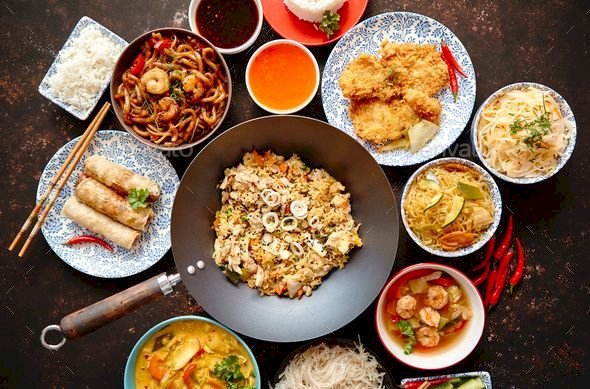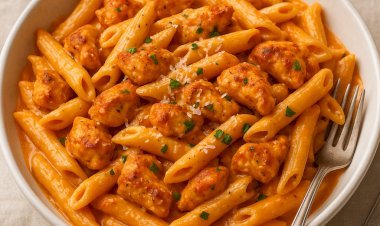Healthy Asian Food Recipes: Nourishing & Flavorful Dishes Better Than Takeout
Discover 20+ healthy Asian food recipes with fresh veggies, lean proteins, and bold flavors—easy, low-sodium dishes better than takeout.

If you love the rich, vibrant flavors of Asian cuisine but want to make healthier choices, you’re in for a delicious surprise. Healthy Asian food recipes are a perfect way to enjoy your favorite dishes without the excess oil, sodium, or sugar often found in takeout. By using fresh vegetables, lean proteins like chicken, tofu, or shrimp, and lighter sauces made from natural ingredients, you can create meals that are both satisfying and good for your body. Asian cooking also offers incredible variety—whether it’s a quick vegetable stir-fry, a steaming bowl of miso soup, or fresh Vietnamese spring rolls, there’s something to suit every taste and dietary need.
From colorful stir-fries packed with crisp seasonal produce to comforting noodle bowls infused with fragrant herbs and spices, these meals deliver the perfect balance of taste and nutrition. Many recipes can be prepared in under 30 minutes, making them ideal for busy weeknights when you want something wholesome but easy. In this guide, we’ll explore a range of healthy Asian food recipes, share expert cooking tips, and suggest smart ingredient swaps to help you enjoy restaurant-quality dishes at home—without compromising on flavor or health.
1. Why Choose Healthy Asian Food Recipes

Image source: www.cookedandloved.com
Asian cuisine offers a colorful and nutritious variety of ingredients—fresh leafy greens, crunchy vegetables, fragrant herbs, and lean proteins like chicken, tofu, and fish. Many traditional dishes feature a balance of vegetables, grains, and protein, making them both satisfying and nourishing.
Healthy Asian food recipes take these traditions a step further by focusing on lighter cooking methods—like steaming, stir-frying, or grilling—instead of deep-frying. They also often replace high-sodium or sugar-heavy sauces with fresh herbs, spices, and homemade dressings that bring out natural flavors.
In the U.S., more people are choosing to cook at home as a way to eat healthier and save money. Preparing your own Asian-inspired meals gives you full control over ingredients, letting you reduce unhealthy fats and sodium while boosting fiber, vitamins, and minerals. This means you can still enjoy the bold, vibrant flavors of your favorite dishes—just in a way that’s better for your body.
Read: If you enjoy getting creative in the kitchen, you might also love our Sugar Cookie Decorating Kit: The Ultimate Guide to Buying & Using (2025) for fun, hands-on dessert projects.
2. Essential Ingredients for Healthy Asian Cooking

Image source: i.pinimg.com
A well-stocked pantry makes preparing healthy Asian food recipes quicker, easier, and a lot more enjoyable. By having the right basics on hand, you can whip up flavorful, nutritious dishes without last-minute store runs.
Here are some must-have staples for healthy Asian cooking:
-
Low-sodium soy sauce or coconut aminos – Essential for seasoning and marinades without overloading on sodium.
-
Rice vinegar – Adds a light, tangy brightness to dressings, stir-fries, and dipping sauces.
-
Sesame oil – Just a few drops bring a rich, nutty aroma; best used at the end of cooking for maximum flavor.
-
Fresh ginger and garlic – Provide depth and warmth; both are also linked to potential health benefits like improved digestion.
-
Lean proteins – Options like tofu, chicken breast, shrimp, and salmon are high in protein and adapt well to many Asian flavors.
-
Fresh vegetables – Bok choy, snap peas, carrots, and broccoli are common in many Asian dishes and add color, texture, and vitamins.
-
Whole grains and noodles – Brown rice, quinoa, and soba noodles (made from buckwheat) offer more fiber and nutrients than refined white rice or regular pasta.
Pro tip: Whenever possible, buy vegetables when they’re in season. They’re fresher, taste better, and often cost less. For guidance, check the seasonal produce chart in section 20 to plan your shopping list.
3. Benefits of Cooking Healthy Asian Meals at Home

Image source: i.pinimg.com
Cooking healthy Asian meals at home offers more than just great taste — it gives you complete control over what goes on your plate. When you cook yourself, you can:
-
Manage portion sizes to fit your health goals and avoid overeating.
-
Choose fresh, minimally processed ingredients, ensuring you get more nutrients and fewer artificial additives.
-
Reduce excess sugar, sodium, and unhealthy fats that are often hidden in restaurant or takeout dishes.
It’s also surprisingly budget-friendly — homemade stir-fries, soups, and rice bowls typically cost less per serving than ordering in. Plus, cooking at home gives you the freedom to adjust flavors to your liking, whether you prefer extra spice, more vegetables, or a lighter sauce. It can even become a fun family activity, with kids helping to wash vegetables, measure ingredients, or stir the pot — making mealtime both healthier and more enjoyable.
4. Simple Stir-Fry Recipes for Busy Nights

Image source: i.pinimg.com
When you’re short on time but still want a wholesome dinner, a stir-fry is your best friend. It’s quick, customizable, and a great way to pack in fresh vegetables and lean protein. Start by heating a wok or large skillet over medium-high heat—using just 1–2 teaspoons of a heart-healthy oil such as avocado, canola, or light olive oil. Sauté minced garlic and freshly grated ginger for 30–60 seconds until fragrant, being careful not to burn them.
Next, add bite-sized vegetables like bell peppers, broccoli florets, and snow peas. Stir-fry for 3–4 minutes, keeping them slightly crisp to preserve nutrients. Add your protein—pre-cooked chicken breast, shrimp, or firm tofu—and toss everything together. Finish with a light sauce made from low-sodium soy sauce or coconut aminos, a splash of rice vinegar, and a drizzle of toasted sesame oil for depth of flavor.
Serve over a bed of steamed brown rice or quinoa for extra fiber and a steady energy release. The entire dish can be ready in about 15 minutes, making it perfect for a busy weeknight without resorting to takeout.
Tip: For even more nutrition, add leafy greens like bok choy or spinach in the last minute of cooking—they wilt quickly and add extra vitamins.
Also check: If you enjoy exploring international flavors, you might also love our guide on Russian Food Recipes Desserts Edition: Cakes, Pastries & Sweets to Try in 2025 for a taste of rich, traditional treats.
5. Nutritious Asian Soups You Can Make in 30 Minutes

Image source: i.pinimg.com
Asian soups are perfect when you want something light, flavorful, and nourishing without spending hours in the kitchen. Favorites like miso, hot and sour, and pho offer a comforting balance of broth, protein, and vegetables. Miso soup, for instance, is made with a savory base of vegetable broth and miso paste, then paired with tofu and seaweed for added protein and minerals. It’s warm, satisfying, and easy to adapt to your taste.
To make these soups even more filling and nutrient-rich, add fresh vegetables such as bok choy, spinach, or mushrooms. They bring extra vitamins, fiber, and texture while keeping the dish low in calories. The beauty of these recipes is their speed—most can be ready in under 30 minutes—making them an excellent choice for healthy weeknight dinners or quick lunches.
6. Healthy Noodle Bowls for Lunch or Dinner

Image source: i.pinimg.com
Noodle bowls are a satisfying way to enjoy a balanced, flavorful meal in one dish. For a healthier base, choose whole grain noodles such as 100% buckwheat soba, brown rice noodles, or whole wheat pasta—these provide more fiber and nutrients than refined noodles. Add a lean protein like grilled shrimp (rich in protein and low in fat), poached chicken breast (a great source of lean protein), or marinated tofu (ideal for plant-based diets).
Pile on colorful vegetables such as shredded cabbage for crunch, cucumber slices for freshness, and julienned carrots for natural sweetness and beta-carotene. For the dressing, whisk together fresh lime juice, a splash of low-sodium soy sauce or coconut aminos (to reduce sodium), a small drizzle of toasted sesame oil, and optionally a sprinkle of chopped herbs like cilantro or Thai basil.
Tip: To make your bowl even more nutrient-dense, add edamame, blanched spinach, or a handful of bean sprouts for extra plant-based protein and texture.
7. Light and Fresh Asian Salads

Image source: i.pinimg.com
Asian salads are known for their bright colors, fresh textures, and bold, zesty flavors. They often combine crunchy vegetables, fragrant herbs, and light yet flavorful dressings that make them both healthy and satisfying. For example, a Thai-inspired chicken salad might include shredded cabbage, thinly sliced carrots, fresh cilantro, and tender grilled chicken breast. A simple dressing of fresh lime juice, fish sauce, and a drizzle of honey brings a balance of tangy, salty, and slightly sweet flavors.
These salads aren’t just delicious—they’re also nutrient-rich. Cabbage and carrots provide fiber, vitamin C, and antioxidants, while lean chicken adds high-quality protein to keep you full. Fresh herbs like cilantro offer additional vitamins and plant compounds that support overall health. Serve chilled for a refreshing lunch or pair with a light soup for a complete, balanced meal.
8. Low-Calorie Asian-Inspired Snacks

Image source: i.pinimg.com
Snacking doesn’t have to mean reaching for chips or cookies. Many traditional Asian snacks are naturally low in calories and packed with nutrients. For example, fresh rice paper rolls filled with shrimp, lettuce, cucumber, and a small amount of vermicelli noodles are light yet satisfying, averaging around 60–80 calories per roll depending on size (USDA estimate). They provide lean protein from shrimp, fiber from vegetables, and slow-digesting carbs from the rice paper and noodles.
Another excellent choice is steamed edamame, lightly sprinkled with sea salt or sesame seeds. A one-cup serving of unshelled edamame contains roughly 120 calories, 9g of protein, and 4g of fiber [USDA FoodData Central], making it a filling, heart-healthy option between meals. You can also enhance the flavor with a squeeze of lemon juice or a dash of chili flakes for an extra kick without adding excess calories.
These snacks are quick to prepare, portable, and nutrient-dense — perfect for keeping energy levels steady without derailing healthy eating goals.
Read Us: If you’re planning a trip to Nevada, you might also enjoy our Ultimate Guide to Free Food in Vegas 2025: Casinos, Buffets & More for insider tips on scoring complimentary meals and snacks during your stay.
9. One-Pot Healthy Asian Dishes

Image source: i.pinimg.com
One-pot Asian meals are a perfect blend of convenience, flavor, and balanced nutrition. Dishes such as Korean kimchi jjigae (a hearty kimchi stew with tofu, vegetables, and optional lean meat), Japanese sukiyaki (thinly sliced beef simmered with vegetables, tofu, and noodles in a savory-sweet broth), and Chinese clay pot chicken (chicken, mushrooms, and vegetables slow-cooked in a light soy-based sauce) are excellent examples.
These recipes combine protein, vegetables, and grains in a single pot, making them ideal for complete, balanced meals. Using a slow cooker or Instant Pot can cut down on active cooking time and enhance flavor as the ingredients simmer together. To make them healthier, use lean cuts of meat, reduce added sodium by choosing low-sodium soy sauce or broth, and add plenty of fresh vegetables like bok choy, carrots, and mushrooms.
10. Healthier Versions of Popular Takeout Meals

Image source: i.pinimg.com
You don’t have to give up your favorite Asian takeout dishes to eat healthier—you can recreate them at home with a nutritious twist. Start by swapping deep-fried proteins for baked or air-fried versions. For instance, making orange chicken with oven-baked chicken breast instead of deep-frying can cut down on added fat and calories, while still keeping the crisp texture you love. Choose whole grain noodles or brown rice for added fiber, and load your plate with colorful vegetables like bell peppers, broccoli, and snap peas. Homemade sauces made with reduced-sodium soy sauce, fresh ginger, garlic, and a splash of citrus will give you that bold takeout flavor—without the excess sugar, sodium, or oil often found in restaurant versions.
11. Vegetarian and Vegan Asian Recipes

Image source: i.pinimg.com
Plant-based Asian dishes are both flavorful and nutrient-dense, offering a variety of textures and tastes. Popular options include tofu and vegetable stir-fry with garlic and ginger, vegetable sushi rolls made with avocado, cucumber, and pickled radish, and a creamy coconut chickpea curry simmered with spices like turmeric and cumin.
For balanced nutrition, these meals often combine soy-based proteins (like tofu or tempeh) with legumes (such as chickpeas or lentils) and whole grains (like brown rice, quinoa, or soba noodles). This combination provides all nine essential amino acids, ensuring complete protein intake for vegan diets. Additionally, incorporating vegetables such as bok choy, bell peppers, and mushrooms boosts fiber, vitamins, and antioxidants, making these recipes both satisfying and nourishing.
Tip: Fermented plant-based ingredients like miso paste and kimchi (made without fish sauce) can add natural umami flavor and probiotics for gut health.
You May Check For Vegan: If you’re looking for convenient plant-based options to complement your home-cooked dishes, check out our guide on Top Vegan Frozen Foods to Try in 2025 – Snacks, Meals & More for quick, tasty, and nutritious choices.
12. Low-Sodium Cooking Tips for Asian Meals

Image source: i.pinimg.com
Cutting back on salt doesn’t mean giving up the bold, satisfying flavors of Asian cuisine. Start by swapping regular soy sauce for low-sodium soy sauce or coconut aminos, which can reduce sodium content by up to 40% compared to standard soy sauce (USDA data). You can also dilute sauces with unsalted vegetable or chicken broth to keep the taste rich while lowering the salt load.
Boost flavor naturally with fresh aromatics like garlic, ginger, lemongrass, and scallions, and finish dishes with cilantro, Thai basil, or a squeeze of lime juice for brightness. Adding a pinch of chili flakes or a dash of rice vinegar can give dishes that same savory punch without relying on extra salt.
Tip: If you’re using packaged condiments such as hoisin or oyster sauce, check the nutrition label—many brands now offer reduced-sodium versions that taste just as good.
13. Meal Prep Ideas for the Week

Image source: i.pinimg.com
Meal prepping is one of the easiest ways to enjoy healthy Asian food recipes throughout the week without the stress of daily cooking. Start by cooking a large batch of brown rice, quinoa, or soba noodles and portion them into containers. Wash, dry, and chop vegetables like bell peppers, carrots, and bok choy in advance so they’re ready to toss into a stir-fry or salad. Marinate proteins such as chicken breast, tofu, or shrimp in resealable bags or containers—most will keep safely in the refrigerator for 2–3 days, according to USDA food safety guidelines. Store each ingredient separately in airtight containers to maintain freshness, and when it’s time to eat, simply combine, heat if needed, and season with your favorite healthy sauces. This approach not only saves time but also helps you stick to healthier choices, especially on busy workdays.
14. Budget-Friendly Healthy Asian Meals

Image source: i.pinimg.com
Eating healthy Asian meals doesn’t have to strain your budget. In fact, many classic recipes rely on simple, inexpensive ingredients that are widely available in U.S. grocery stores. Frozen vegetables are a smart choice because they’re picked and flash-frozen at peak ripeness, locking in nutrients and reducing food waste. Canned beans—such as edamame, chickpeas, or black beans—are affordable sources of plant-based protein and fiber. Chicken thighs are another great option; they’re often cheaper than chicken breasts, stay tender during cooking, and work well in stir-fries, curries, and soups.
For even more savings, consider visiting local Asian grocery stores. These markets often stock fresher herbs like Thai basil and cilantro, authentic sauces, and specialty produce at lower prices compared to mainstream supermarkets. You can also buy pantry staples like rice, noodles, and soy sauce in larger quantities, which cuts down on per-meal costs.
Tip: Planning meals around weekly store specials and seasonal vegetables—such as bok choy in winter or zucchini in summer—can help you enjoy authentic flavors while keeping your grocery bill in check.
15. Popular Herbs and Spices in Asian Cooking

Image source: i.pinimg.com
Cilantro, Thai basil, lemongrass, ginger, and chili peppers are staples in many Asian cuisines, each offering unique flavors and potential health benefits backed by credible sources. Cilantro provides a fresh, citrusy note and contains antioxidants that may help protect cells from damage. Thai basil adds a slightly spicy, anise-like aroma and is rich in vitamin K, which supports bone health. Lemongrass brings a bright, lemony flavor and contains compounds that may have antimicrobial properties. Ginger is well-known for aiding digestion and helping to reduce nausea, while chili peppers provide a fiery heat along with capsaicin, a compound studied for its potential metabolism-boosting effects.
In addition to flavor, these herbs and spices can help you reduce reliance on salt and sugar in recipes, making them a valuable part of healthy Asian food recipes for anyone looking to cook flavorful yet health-conscious meals.
16. Storing and Reheating Leftovers

Image source: i.pinimg.com
Proper storage keeps your healthy Asian food recipes fresh and safe to eat. Most cooked dishes—such as stir-fries, soups, or curries—can be stored in airtight containers in the refrigerator for 3–4 days. Always allow food to cool slightly before sealing to prevent excess moisture buildup, which can lead to sogginess.
When reheating, skip the microwave if possible. Using a skillet, wok, or steamer helps restore texture, especially for stir-fried vegetables and noodles. For soups and broths, reheat gently over medium heat until steaming hot (165°F / 74°C) to ensure food safety, as recommended by the USDA. If freezing, portion meals into freezer-safe containers and consume within 2–3 months for best flavor.
Tip: If reheating noodles or rice, sprinkle a teaspoon of water over them before warming—this helps bring back moisture and prevents them from drying out.
17. Regional Varieties in Healthy Asian Cooking

Image source: i.pinimg.com
Asian cuisine is incredibly diverse, with each country offering unique flavors, cooking techniques, and healthy options that can be enjoyed at home. Here are some examples of nutritious dishes from different regions:
Japanese:
-
Miso Soup – A light, umami-rich broth made with miso paste, tofu, seaweed, and scallions. Naturally low in calories and high in minerals like iodine.
-
Teriyaki Salmon (Low-Sodium Sauce) – Grilled or baked salmon glazed with a reduced-sodium teriyaki sauce, offering heart-healthy omega-3s.
-
Sushi Bowls – Deconstructed sushi served over brown rice or quinoa, topped with vegetables and lean protein.
Thai:
-
Light Green Curry – A flavorful coconut-based curry made lighter with reduced-fat coconut milk and extra vegetables.
-
Papaya Salad (Som Tum) – A refreshing mix of shredded green papaya, lime juice, tomatoes, and peanuts, naturally low in fat.
-
Fresh Summer Rolls – Rice paper rolls filled with shrimp, herbs, and crunchy vegetables, served with a light dipping sauce.
Chinese:
-
Steamed Dumplings – Filled with vegetables, chicken, or shrimp, steamed instead of fried to cut down on fat.
-
Stir-Fried Greens – Quick-cooked bok choy, gai lan, or spinach seasoned with garlic and a splash of low-sodium soy sauce.
-
Egg Drop Soup – Light chicken broth with whisked eggs and vegetables, providing protein without heavy oils.
Korean:
-
Brown Rice Bibimbap – A colorful rice bowl with assorted vegetables, lean protein, and a spicy gochujang sauce (in moderation).
-
Kimchi Stew (Kimchi Jjigae) – A warming soup made with fermented kimchi, tofu, and vegetables, rich in probiotics.
-
Bulgogi Lettuce Wraps – Thin slices of marinated beef served in lettuce leaves with fresh herbs.
Vietnamese:
-
Lean Pho – A fragrant rice noodle soup with lean beef or chicken, fresh herbs, and plenty of vegetables.
-
Fresh Spring Rolls – Soft rice paper rolls filled with shrimp, herbs, lettuce, and vermicelli noodles.
-
Banh Xeo (Vietnamese Crepes) – Crispy turmeric crepes filled with vegetables and lean protein, cooked with minimal oil.
You May Check More For healthy Option: If you’re also looking for soft, nutrient-packed options for healing or special diets, check out our guide on High Protein Pureed Food Recipes: Easy, Nutritious Meals for Recovery & Wellness.
18. Quick “Make It Healthier” Swaps

Image source: i.pinimg.com
Small, smart ingredient swaps can cut calories, reduce fat, and add extra nutrition—without sacrificing flavor.
-
Pad Thai: Replace half the rice noodles with spiralized zucchini or carrot noodles. This lowers refined carbs and adds fiber while keeping the dish colorful and satisfying.
-
Fried Rice: Swap white rice for cauliflower rice or a 50/50 mix of cauliflower rice and brown rice. This reduces calories and boosts vegetable intake without drastically changing the texture.
-
Tempura: Instead of deep-frying battered vegetables or shrimp, lightly coat them in panko breadcrumbs or tempura batter and bake in a hot oven (425°F) until crispy. This cuts oil use and still gives a crunchy bite.
-
Coconut Milk: Use light coconut milk in curries and soups instead of full-fat. This simple change can reduce the saturated fat content by up to 50%, while keeping the rich, creamy texture.
Tip: When making swaps, adjust seasonings and cooking times to ensure the flavors and textures remain appealing.
Sample Nutrition Facts – Vegetable Stir-Fry (1 Cup Serving)

Image source: i.pinimg.com
|
Nutrient |
Amount |
Daily Value (%DV*) |
|
Calories |
180 |
9% |
|
Protein |
7–8g |
14% |
|
Carbohydrates |
23–25g |
8% |
|
Dietary Fiber |
3–4g |
12% |
|
Total Fat |
6g |
8% |
|
Saturated Fat |
1g |
5% |
|
Sodium |
350–380mg |
15% |
|
Vitamin C |
40–50mg |
50% |
|
Vitamin A |
3000–3500 IU |
60% |
Percent Daily Values are based on a 2,000-calorie diet.
Source: USDA FoodData Central – Based on a mixed vegetable stir-fry with light soy sauce and minimal oil.
Tip: You can lower the sodium to under 200mg by using low-sodium soy sauce or coconut aminos, and you can boost protein by adding tofu, chicken, or shrimp.
19. U.S. Ingredient Swap Guide for Asian Cooking

Image source: i.pinimg.com
Finding authentic Asian ingredients can be tricky in some U.S. grocery stores, but you can still capture similar flavors with smart substitutions. These swaps won’t be exact matches, but they’ll get you close while keeping dishes tasty and balanced.
-
-
Thai Basil → Fresh Basil + Mint Combo
Thai basil has a subtle anise-like flavor. If unavailable, mix 2 parts fresh basil with 1 part fresh mint to mimic its fragrant profile. -
Rice Vinegar → Apple Cider Vinegar (Diluted)
Rice vinegar is mild and slightly sweet. Replace with apple cider vinegar diluted with a little water (3 parts vinegar, 1 part water) to soften its sharpness. -
Fish Sauce → Soy Sauce + Lime Juice
Fish sauce adds salty, umami depth. Combine 2 teaspoons soy sauce with a few drops of fresh lime juice to mimic both the savoriness and brightness. -
Soba Noodles → Whole Wheat Spaghetti (Cooked Al Dente)
Buckwheat soba has an earthy taste and chewy texture. If you can’t find it, whole wheat spaghetti is a good stand-in—just avoid overcooking so it retains a firm bite.
-
20. Seasonal Produce for Healthy Asian Recipes in the U.S.

Image source: i.pinimg.com
Eating seasonally not only boosts flavor and freshness but can also save money. Here’s a guide to vegetables and herbs commonly available in the U.S. during each season — and how they fit into healthy Asian food recipes.
|
Season |
Vegetables & Herbs |
How to Use in Asian Recipes |
|
Spring |
Asparagus, spinach, scallions, mint, snow peas, radishes |
Stir-fry asparagus with garlic and sesame oil; add spinach to miso soup; use scallions in noodle dishes; fresh mint is perfect for Vietnamese spring rolls. |
|
Summer |
Bell peppers, cucumbers, basil, zucchini, eggplant, green beans |
Bell peppers brighten up stir-fries; cucumbers add crunch to Asian salads; Thai basil enhances curries; zucchini works well in low-carb Pad Thai; eggplant can be grilled with miso glaze. |
|
Fall |
Broccoli, bok choy, carrots, ginger, daikon radish, napa cabbage |
Broccoli and bok choy shine in garlic-ginger stir-fries; carrots add sweetness to soups; ginger is a base for many sauces; napa cabbage is perfect for kimchi. |
|
Winter |
Cabbage, mushrooms, kale, garlic, leeks, Brussels sprouts |
Cabbage is ideal for hearty noodle soups; mushrooms add umami to hot pots; kale can be stir-fried with sesame oil; garlic boosts flavor in almost every dish. |
Tip: Even in off-seasons, you can use frozen vegetables like broccoli, spinach, and edamame — they retain most of their nutrients and are convenient for quick weeknight cooking.
Average Monthly Cost of Cooking Healthy Asian Meals at Home (2025)

Image source: i.pinimg.com
|
Category |
Estimated Cost (USD) |
|
Fresh Vegetables & Herbs |
$45 – $65 |
|
Proteins (Chicken, Tofu, Fish, Eggs) |
$55 – $75 |
|
Sauces, Oils & Condiments |
$18 – $28 |
|
Grains & Noodles (Rice, Quinoa, Soba) |
$22 – $32 |
|
Estimated Total |
$140 – $200 |
Source: U.S. Department of Agriculture Food Plans, 2025 – adjusted for typical Asian ingredient usage and U.S. grocery prices.
What this means for you: Cooking healthy Asian food recipes at home can cost significantly less than dining out. For comparison, an average takeout meal in the U.S. costs between $12–$18 per person—meaning just 8 restaurant meals could exceed your entire monthly grocery budget for these home-cooked dishes. Plus, you’ll have the benefit of fresher, healthier ingredients and the ability to customize flavors to your taste.
Also Read: If you love exploring food events as much as cooking at home, don’t miss our guide to the Sweet Corn Festival 2025: Dates, Locations & Family Fun Guide for a fun-filled family outing.
Conclusion
Cooking at home with healthy Asian food recipes is a delicious way to enjoy vibrant flavors while making healthier choices for yourself and your family. By using fresh vegetables, lean proteins, whole grains, and lighter sauces, you can create meals that support balanced nutrition and long-term health goals, whether that’s weight management, heart health, or simply eating more wholesome foods. Start with simple dishes you enjoy, experiment with herbs and spices from different Asian cuisines, and gradually add new recipes to your routine. The more you cook, the more confident you’ll become in creating flavorful meals that rival your favorite restaurant dishes—only fresher, healthier, and made exactly the way you like them.
FAQs
Q: What are the healthiest Asian dishes to make at home?
Some of the healthiest options include steamed fish with ginger and scallions, vegetable stir-fries made with minimal oil, miso soup rich in probiotics, and fresh Vietnamese spring rolls packed with herbs and lean protein. These dishes are naturally nutrient-rich, high in fiber, and low in unhealthy fats when prepared at home.
Q: Can healthy Asian food recipes be made gluten-free?
Absolutely. Many traditional Asian ingredients are naturally gluten-free, such as rice, rice noodles, and most fresh vegetables. To make sauces gluten-free, swap regular soy sauce for tamari or coconut aminos. Also, check packaged condiments (like hoisin or oyster sauce) for hidden gluten.
Q: Are these recipes good for weight loss?
Yes, when prepared with fresh ingredients and controlled portions. Many healthy Asian recipes emphasize vegetables, lean protein, and lighter cooking methods like steaming or stir-frying, which can help reduce calorie intake. Pairing them with whole grains like brown rice or quinoa can keep you feeling full longer.
Q: How can I reduce sodium in Asian cooking?
Use low-sodium soy sauce, tamari, or coconut aminos, and dilute sauces with low-sodium broth or water. Boost flavor with fresh herbs, garlic, ginger, vinegar, and citrus juice instead of relying solely on salt. Cooking at home also lets you avoid the high-sodium sauces often used in takeout.
Q: Do I need special equipment to make healthy Asian dishes?
Not necessarily. A sturdy non-stick skillet or wok, a sharp chef’s knife, and a cutting board are enough for most recipes. However, having a steamer basket, rice cooker, or mortar and pestle can make certain traditional dishes easier to prepare and more authentic in flavor.

 Selina Smith
Selina Smith 















